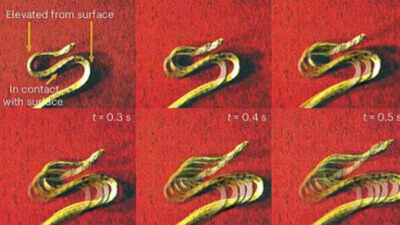ARTICLE AD BOX

Source: Harvard University
Researchers from IIT-Bombay and Harvard University have discovered a previously unreported S-shaped escape movement in young yellow anacondas. This rapid, non-planar motion, termed the "S-start," is employed by juvenile anacondas to swiftly evade threats.
Through high-speed video analysis and a biophysical model, the study elucidates the biomechanics of this unique gait, revealing that it involves localized muscular torque generating an S-curve and out-of-plane lifting. Notably, this gait is exclusive to juveniles due to their optimal strength-to-weight ratio. The findings offer valuable insights for designing snake-like robots capable of navigating confined spaces, advancing the field of soft robotics.
The study also suggests that the S-start may be an evolutionary precursor to other snake locomotion strategies, such as sidewinding and lasso motion.
Young anacondas and its new S-shaped locomotion identified
When imagining a snake, the familiar wave-like slithering often comes to mind—a graceful, friction-defying motion studied extensively by zoologists. However, snakes are capable of far more complex movement strategies:
- Climbing: Some species scale trees using muscular contractions and body anchoring.
- Gliding: Certain arboreal snakes can glide through the air, controlling their body curvature mid-flight.
- Ground navigation: Using rectilinear motion, lateral undulation, and sidewinding, snakes traverse uneven terrain efficiently.
The newly observed S-start gait, predominantly in juvenile yellow anacondas, represents a transient, non-planar motion designed for speed rather than energy conservation.
How young anacondas move without limbs
Despite lacking limbs, snakes navigate their environment with remarkable agility. This is possible due to a combination of internal skeletal structure and external scales:
- Flexible spine: Hundreds of curved ribs run the length of the body, allowing twisting and bending.
- Muscles: Attach to ribs, generating forces that propel the snake forward.
- Scales: Keratin-based scales provide directional friction—belly scales for grip, back scales for smooth sliding.
This anatomy enables diverse locomotion types:
- Lateral undulation: Sine-wave movement traveling from side to side.
- Rectilinear motion: Alternating muscular expansions along the belly.
- Concertina locomotion: Accordion-like folding and extension.
- Sidewinding: Out-of-plane helical motion ideal for sandy or slippery surfaces.
Unlike steady sidewinding, the S-start is pulsed: a sudden burst of muscular force propels the snake forward briefly, stopping before repeating.
How researchers studied the s-start gait in young anacondas
To understand this motion, researchers conducted locomotion trials on newborn, juvenile, and adult yellow anacondas under simulated threats.
High-speed video captured the S-start gait, while a biophysical model treated the snake as an elastic rod interacting with frictional forces, gravity, and muscular torque.Key findings include:
- S-shape formation: Three straight sections connected by two sharp curves.
- Out-of-plane lifting: Curved regions lift while outer straight sections slide forward.
- Propulsion mechanics: Curved sections move along the body, generating rapid forward movement.
This model confirmed that localized muscular torque is critical, with in-plane torque shaping the S-curve and out-of-plane torque producing lift.
Why only young anacondas
The S-start gait is restricted to newborn and juvenile snakes. The reason lies in biomechanics:
- Weight-to-strength ratio: Young snakes have less weight but proportionally stronger muscles relative to their body mass.
- Adults are heavier: Bone mass increases with growth, but muscular strength does not scale equally.
- Torque limitations: Heavier adults cannot lift body segments effectively, making the gait mechanically impossible.
This suggests an evolutionary adaptation, allowing smaller snakes to escape predators rapidly, while larger individuals rely on different locomotion strategies.
How snake motion guides robot innovation
Understanding the S-start gait has significant applications in soft robotics:
- Snake-like robots: Can navigate narrow or complex terrains by mimicking juvenile snake motions.
- Design optimization: Mathematical modeling of torque and body flexibility informs efficient robot movement.
- Broader applications: Insights extend to other limbless organisms like worms and inchworms.
As Raghunath Chelakkot from IIT-Bombay notes, studying complex locomotion in living organisms can challenge existing elastic theories and inspire innovative robotic systems.
How the s-start gait shapes other snake movements
The study indicates that S-start may be a foundational movement for multiple out-of-plane gaits:
- Sidewinding: Achieved with periodic torque patterns.
- Lasso motion: Observed in tree-climbing snakes.
This points to an evolutionary role for S-shaped locomotion in enabling versatile movement strategies across diverse environments.Also Read | Did you know alligators can climb trees? Explore the fascinating facts of American alligators, habitat, behaviour, diet and more



.png)
.png)
.png)
















 1 week ago
4
1 week ago
4








 English (US) ·
English (US) ·